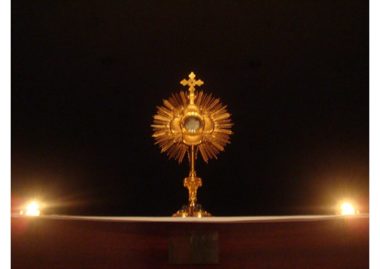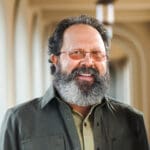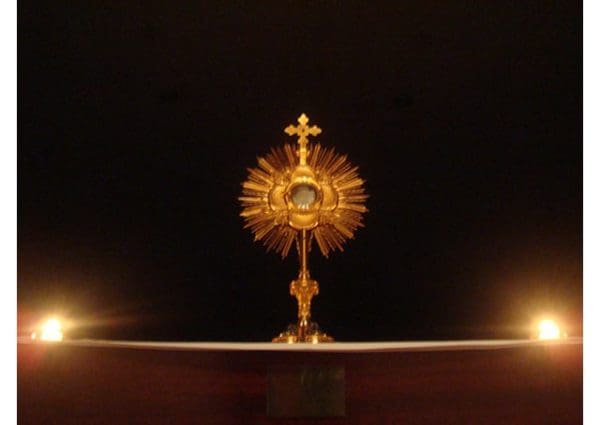There is no monitor or video screen at eucharistic adoration, no figures or colors shifting across the screen. We simply sit and look at a round piece of bread encircled by light. That bread is the Body of Christ, the consecrated Host, before which countless Catholics gaze in rapt adoration throughout the world.
Why? There is no action here: here the action is being, the very being of God. Martha goes busily about, tending to all the needs of the world. Here, before Jesus in sacramental form, Mary finds her place, seated at the feet of the Beloved.
about, tending to all the needs of the world. Here, before Jesus in sacramental form, Mary finds her place, seated at the feet of the Beloved.
“Jesus Christ: body, blood, soul and divinity.” If anyone ever seems unsure about just what happens to the bread during Mass, I repeat this phrase taught Catholics from time immemorial, indicating precisely what-or rather, Who-is present in what appears to be bread, but is bread no longer.
There is no want of corrosive doubt these days. Yet much doubt on the seemingly lesser mysteries of our faith reveals a lack of faith in the central mysteries. “Do you really mean to tell me that the consecrated bread is Jesus Christ?” It flows from the question: “Do you really mean to tell me that this man, Jesus Christ, is God?” “Yes,” witnesses the Church: “God has become man in Jesus Christ.”
And if we read chapter 6 of John’s Gospel, with the mind of the Church, it is perfectly clear that He, the Son of God, extends His incarnation in the world by transforming bread and wine into himself for us. The statement stands boldly and nakedly at the heart of our Catholic worship: “This is My Body …. This is My Blood.” At that moment, heaven and earth become one in this bread and wine, which are God become food for His world.
Mystics throughout history have experienced tremendous graces in the presence of the Blessed Sacrament. And so have ordinary people, the eyes of whose hearts are opened by faith.
Recently, a friend told me he found himself in one of the periodic bouts of restlessness – we all, I suppose, experience. “Ah,” he thought, “if only I were in a hermitage or a monastery, removed from the pressures of worldly life, how close I could be again to the Lord!” Yet one morning as he said Mass, his heart heard an admonition, as from the Host on the altar, saying: “I am right here and you have no need to go anywhere else.” Incredible.
I sometimes ask my students where they can find Jesus Christ. True to the radical humanism of our day, they like to point to themselves, or point to other people. Well, yes, I say, in a way that is true. “But,” I ask, “if you wanted to be with Christ directly, personally: if you wanted to pour out your heart to Him – just you and He – if you wanted to adore Him Who is God made man, where would you go?” Eventually, one hand is sheepishly raised in the classroom and a witnessing voice quietly says, “He is in the tabernacle in church.”
He is as much present in the tabernacle near our homes as He is at the Vatican, or Jerusalem, at Lourdes, Fatima or any other holy place to which people travel. In fact, no place on earth is more holy than the tabernacle in our local sanctuary. Every Mass, every consecration, is a miracle, greater by far than any other, really: for God to come into matter and transform it into himself is far greater than His creating that matter in the first place.
That is why, of course, Catholics have always shown a special reverence in their churches by genuflecting when entering the presence of the sovereign King who is really and truly there; by assuming stances of adoration, kneeling, for it is, in fact, God who is present there; by keeping silent in His presence, so that He might speak and they might hear what He has to say.
His presence is called “real,” for in the end, it is not we who are real, the piece of consecrated bread a mere symbol; no, our reality in this earthly form is passing away. Right now we have this human form, but what we shall be is up to God, and none of us has seen it, this side of death (1 Jn 3:2). We, who seem so real, are really mere phantoms of a day, our flesh grass that will pass away as we fall into the inscrutable mercy of God. But now He comes to us as nourishment, as the food of life. And as we change, we shall come to see the face of Him who has chosen to be among us as one who serves, and who serves by giving us His Body to eat, His Blood to drink, His presence to adore.
The doctrine of the Real Presence means that Jesus is no less present in the Eucharist today than He was at the home of Martha and Mary. “Oh,” someone might say, “we have the Eucharist on earth: the historical Jesus lived back then; the risen Jesus is in heaven.” But don’t you see? In Jesus, earth and heaven became fully one, fully wed: the risen Jesus is earth taken up into heaven.
In Him, the wedding feast has begun. And Jesus is God, the Lord of heaven, made visible and tangible for us: seeing Him, we see the Father (Jn 14:9). Our fleshly eyes see bread, for being earth all they see is earth. But cloaked beneath that form of bread and wine is Jesus Christ, whose risen Body is the heart of heaven. About Him dance all the company of angels and saints in mirthful adoration. And some children of earth kneel and sit at this gate to heaven, looking up longingly through the circle of light that is heaven’s heart, and while they are there, all of earth gives way like husks that yield a flower: in His presence all is peace, all is light.
The Eucharist is a real, ongoing presence, not just a moment of communion, but an ongoing being with, and abiding, the eternal reality of the Incarnation, present “in every tabernacle of the world until the end of time,” as the prayer puts it. In our day, eucharistic adoration has become an ever more popular way to be in the presence of Jesus, to adore Him: a way to be in heaven while on earth.
The greatest peace, calm and joy comes from being in the presence of the “Bridegroom of our souls.” No one, certainly nothing else on this earth, will ultimately satisfy our deepest longings. In all creation, in all the beautiful things and people He has made, we see something of Him.
In the Eucharist, we see Him. Not as we shall see Him when we leave this world, not as He wants to be known by us in eternity, but in the form in which He has chosen to come to us on our earthly journey. Someday, when this present darkness ends and God is “all in all,” we shall see His beloved face, and we shall be embraced by and love the One Who made us out of love, redeemed us, gave himself to darkest death for us.
For now, we gaze up at Him as our food encircled by light. The Eucharist we adore is the window to heaven, the true Body of Our Lord. He, and none other: here, if anywhere. “Oh come let us adore Him.”
by Father Raymond T. Gawronski, S.J.
Fr. Gawronski recently passed to his eternal reward. As an expression of thanks for his life and work, please take a moment to pray for the repose of his soul.





